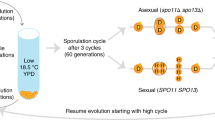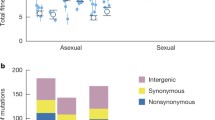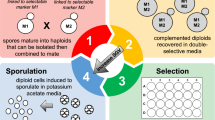Abstract
It is generally believed that recombination by sexual reproduction is unfavourable in constant environments but is of adaptive value under changing environmental conditions. To test this theory, experimental populations of yeast (Saccharomyces cerevisiae) were set up and maintained at different levels of environmental heterogeneity. Recombination was estimated by determining sporulation rates. Sporulation rates first increased in populations living in highly variable environments, but after some time began to decrease. The decrease started last and was slowest in populations which were maintained under the same conditions for a sufficiently long time, to allow some adaptation of the gene pool to the respective environment. Patterns of genotypic variability could not be interpreted in such simple terms, but there was a statistically significant correlation between sporulation rate and genotypic variability. This correlation is to be expected because recombination generates genotypic variability. Summing up, recombination by sexual reproduction is advantageous in changing environments if the population can track the changes in the environment by changing its genotypic structure.
Similar content being viewed by others
References
Charlesworth, B., 1976. Recombination modification in a fluctuating environment. Genetics 83: 181–195.
Cox, D. R. & Stuart, A., 1955. Some quick sign tests for trend in location and dispersion. Biometrika 42: 80–95.
Felsenstein, J. & Yokoyama, S., 1976. The evolutionary advantage of recombination. — II. Individual selection for recombination. Genetics 83: 845–859.
Fisher, R. A., 1930. The genetical theory of natural selection. Oxford University Press, Oxford.
Lewontin, R. C., 1972. The apportionment of human diversity. Evolutionary Biology 6: 381–398.
Lynch, M. & Gabriel, W., 1983. Phenotypic evolution and parthenogenesis. Am. Nat. 122: 745–764.
Maurer, H. R., 1968. Disk-Eiektrophorese. Walter de Gruyter, Berlin.
Maynard Smith, J., 1971a. The origin and maintenance of sex. In: Williams, G. C. (ed.), Group selection. Aldine-Atherton, Chicago.
Maynard Smith, J., 1971b. What use is sex? J. theor. Biol. 30: 319–335.
Maynard Smith, J., 1976. A short-term advantage for sex and recombination through sib-competition. J. theor. Biol. 63: 245–258.
Maynard Smith, J., 1978. The evolution of sex. Cambridge University Press, Cambridge.
McDonald, J. F. & Ayala, F. J., 1974. Genetic response to environmental heterogeneity. Nature 250: 572–574.
Minawa, A. & Birley, A. J., 1978. The genetical response to natural selection by varied environments. I. Short-term observations. Heredity 40: 39–50.
Muller, H. J., 1932. Some genetic aspects of sex. Am. Nat. 66: 118–138.
Nei, M., 1975. Molecular population genetics and evolution. North-Holland, Amsterdam.
Orthen, E., Lange, P. & Wöhrmann, K., 1984. The effect of newly induced mutations on the fitness of genotypes and populations of yeast (Saccharomyces cerevisiae). Mutation Research 129: 327–335.
Powell, J. R., 1971. Genetic polymorphisms in varied environments. Science 174: 1035–1036.
Powell, J. R. & Wistrand, H., 1978. The effects of heterogeneous environments and a competitor on genetic variation in Drosophila. Am. Nat. 112: 935–947.
Shaw, C. R. & Prasad, R., 1970. Starch gel electrophoresis: a compilation of recipes. Biochem. Genet. 4: 297–320.
Strobeck, C., Maynard Smith, J. & Charlesworth, B., 1976. The effect of hitch-hiking on a gene for recombination. Genetics 82: 547–558.
Strobel, R. & Wöhrmann, K., 1977. The influence of defined gene blocks on the competitive ability of yeast genotypes. Biochem. Genet. 15: 1015–1021.
Strobel, R. & Wöhrmann, K., 1978. The selective importance of allozymes in yeast populations. Egypt. J. Genet. 7: 108–122.
Treisman, M., 1976. The evolution of sexual reproduction: A model which assumes individual selection. J. theor. Biol. 60: 421–431.
Williams, G. C., 1975. Sex and evolution. Princeton University Press, Princeton.
Wolf, H. G., 1980. Untersuchungen zum adaptiven Wert des sexuellen Fortpflanzungszyklus bei Saccharomyces cerevisiae. Dissertation, Tübingen.
Wolf, H. G. & Wöhrmann, K., 1981. The sexual behaviour of yeast (Saccharomyces cerevisiae) in experimental populations. Proc. 1st. Mediterranean Conf. Genet., Cairo: 445–457.
Author information
Authors and Affiliations
Rights and permissions
About this article
Cite this article
Wolf, H.G., Wöhrmann, K. & Tomiuk, J. Experimental evidence for the adaptive value of sexual reproduction. Genetica 72, 151–159 (1987). https://doi.org/10.1007/BF00123174
Received:
Accepted:
Issue Date:
DOI: https://doi.org/10.1007/BF00123174




